Understand the process creation
Concept, motivation, code, examples
Definition
- fork() is the primary method of process creation of an operating system like Unix.
The newly created process is known as the Child process, and the process from which the child process is created is known as the Parent process.
-
The C fork() function returns a negative value when the function fails to create a child process.
-
The C fork() function returns a zero value to the child process that is newly created. On successful duplication of a process, the PID of the child process is returned in the parent, and 0 is returned in the child process.
-
The C fork() function returns a positive value to the parent process or the caller. The positive value consists of the process ID of that particular child process that is being created.
How to get the pid:
pid_t pid = fork();
Why do we want to create processes
Let's see some practical applications of fork:
- Shell uses fork to run programs that you invoke from cmd.
- Web servers like apache use fork to create multiple server processes, each of which handles requests in its own address space.
- Google Chrome uses fork to handle each page within separate process. See more on further reading
- When you want to isolate parts of the applications and if they crash/ leak memory/ misbehave, they can be killed/restarted without killing entire application
- By hackers (put here for learning purposes): Fork bomb
- Used in pipes, two processes that work together. Send information to each other.
How is it in code
#include <stdio.h>
#include <sys/types.h>
#include <unistd.h>
int main()
{
fork();
printf("Hello world!\n");
return 0;
}
Output:
Hello world!
Hello world!
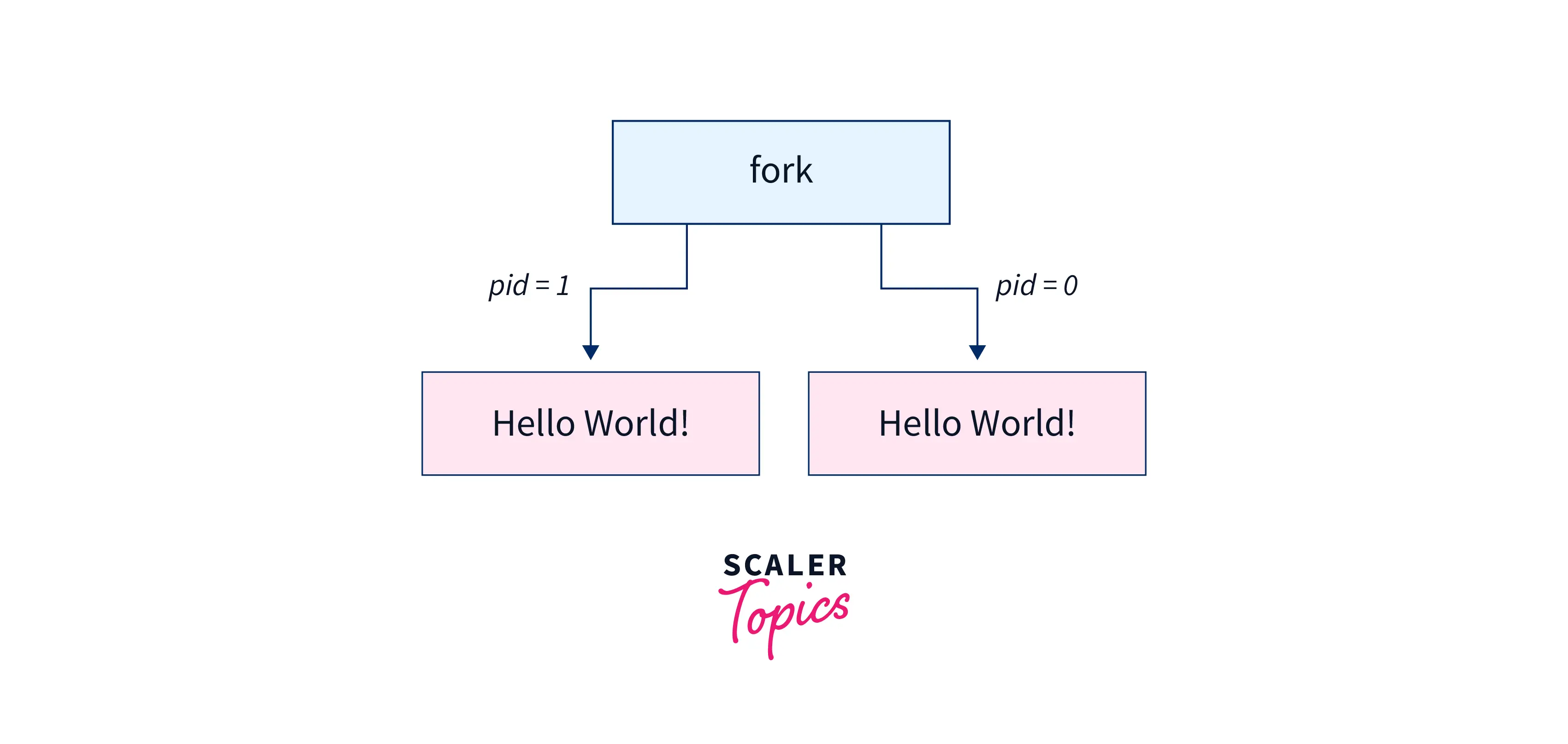
In the example above, what is below the fork will be copied to the new process (child) and will be executed.
So, printf will be run by parent and child.
🍵 Coffee break with some memes



Sample for code visualization
Before getting deeper, there is a sample code we will give you. It will generate an image based on what processes are created in a C file.
Prerequisites : Download graphviz on your machine.
Usage :
- Create a file named
forks.log - Run the
script.pycode in a separate terminal - Run the
template.c
import os
import time
import graphviz
log_file_path = 'forks.log'
dot = graphviz.Digraph(comment='Forks')
def update_graph():
global dot
dot = graphviz.Digraph(comment='Forks')
with open(log_file_path, 'r') as file:
lines = file.readlines()
for line in lines:
if line.strip():
parts = line.split()
parent = parts[1]
child = parts[3]
dot.node(parent, f'Parent {parent}')
dot.node(child, f'Me {child}')
dot.edge(parent, child)
output_filename = 'forks_graph'
dot.render(output_filename, format='png')
print(f"Graph updated and saved as {output_filename}.png")
def monitor_log():
if not os.path.exists(log_file_path):
print(f"No log file found at {log_file_path}")
return
last_size = os.path.getsize(log_file_path)
while True:
update_graph()
time.sleep(3)
if __name__ == "__main__":
monitor_log()
#include <stdio.h>
#include <unistd.h>
#include <sys/types.h>
#include <sys/wait.h>
#include <stdlib.h>
void clear_log() {
FILE *log_file = fopen("forks.log", "w");
if (log_file != NULL) {
fclose(log_file);
}
}
void log_fork(pid_t parent, pid_t child) {
FILE *log_file = fopen("forks.log", "a");
if (log_file != NULL) {
fprintf(log_file, "Parent %d Me %d\n", parent, child);
fclose(log_file);
}
}
int main() {
clear_log();
// Try me
// fork();
log_fork(getppid(), getpid());
return 0;
}
Examples
Part 1 - Show the picture, recreate the code
Exercise 1:
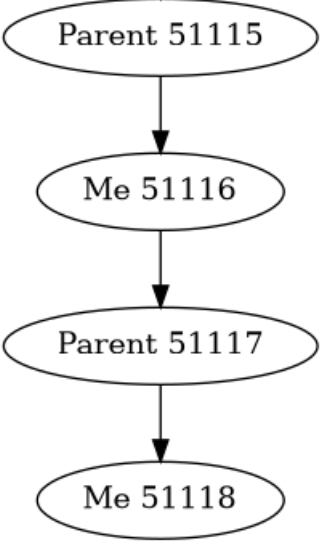
💡Solution
if(!fork()){
if(!fork()){
fork();
}
}
Explanation:
First, the first fork() is done, then if(!fork()) means that the code continues if we are in the child process.
Exercise 2

💡Solution
if(fork()){
if(fork()){
fork();
}
}
Explanation:
First, the first fork() is done, then if(fork()) means that the code continues if we are in the parent process.
Exercise 3:
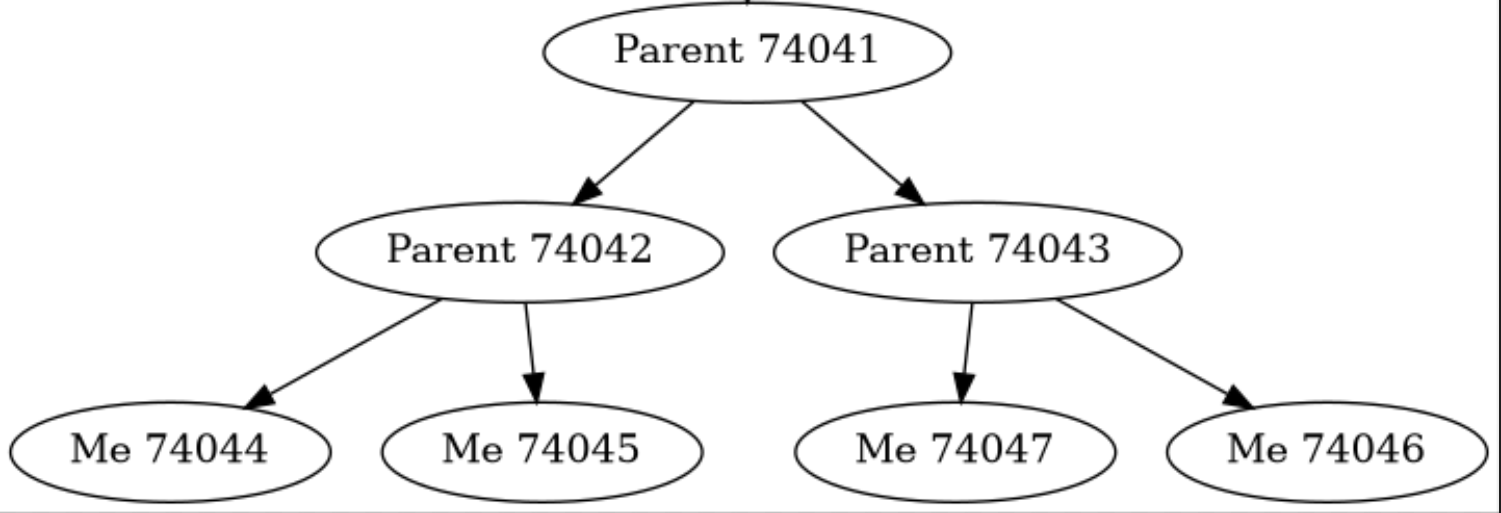
💡Solution
if(!fork()){
if(fork()){
fork();
}
}else{
if(!fork()){
if(fork()){
fork();
}
}
}
Exercise 4 (try to solve it and then verify the solution with the sample code)
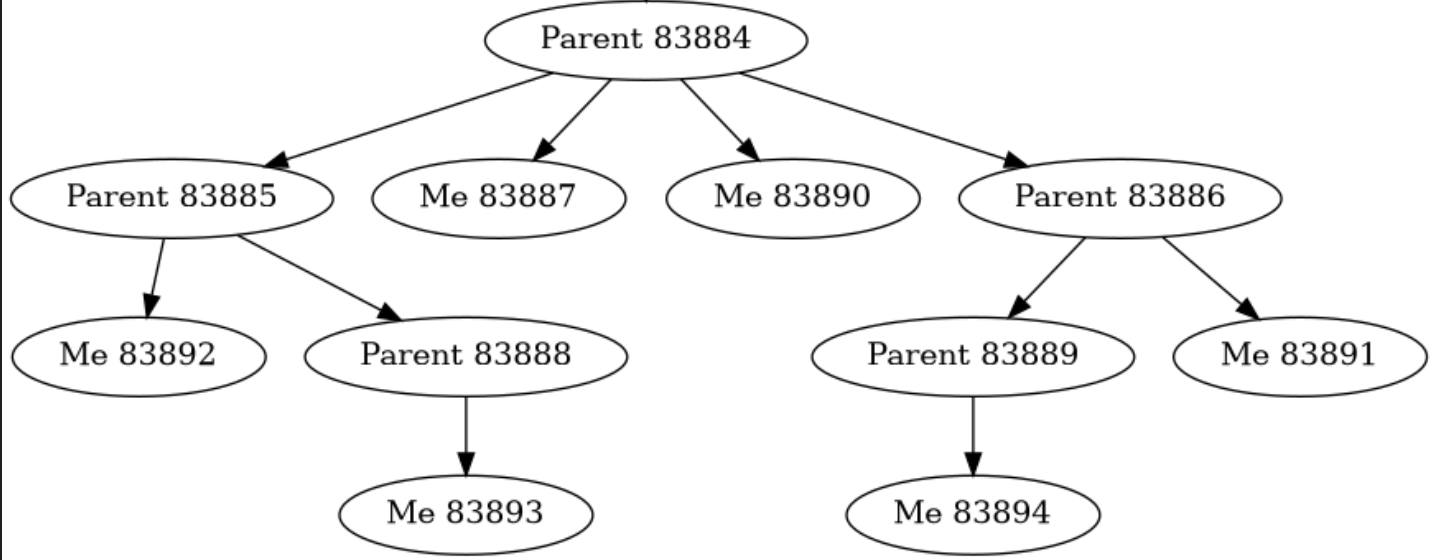
Part 2 - Having the code, create the image
Exercise 1
for(int i = 0; i < 2; i ++){
if(fork()){
fork();
}
}
💡Solution

Explanation:

Exercise 2
For this one, find what it looks like, but also what is the formula to calculate how many new processes are created for any n given.
int n = 2;
for(int i = 0; i < n; i ++){
for(int j = i; j >= 0; j --){
fork();
}
}
💡Solution
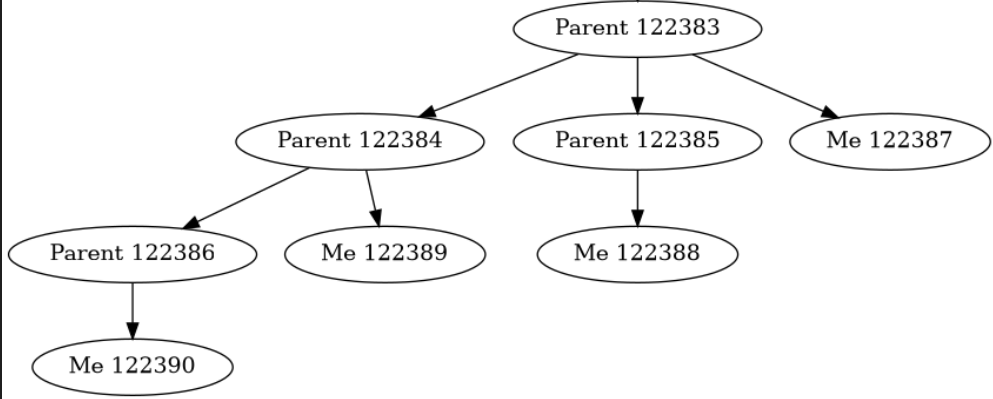
Formula: 2^(n * (n + 1) / 2) - 1
Human form: 2^(how many forks are made) - (the main process which is not new)
Exercise 3
if(fork() || fork()){
fork();
}
💡Solution
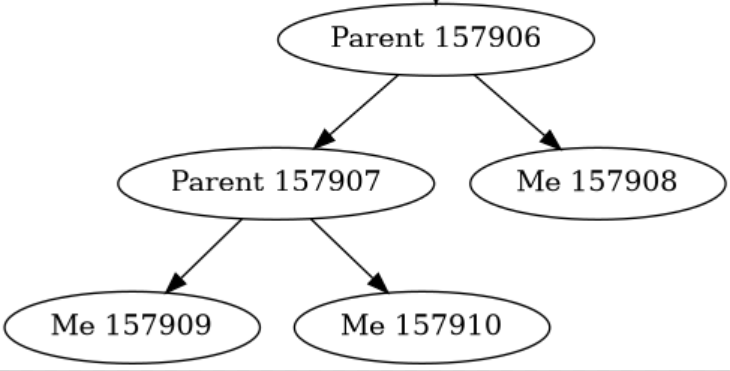
This one is tricky. First it does the fork() and now we have the parent and the child.
The parent returns something > 0 and the child returns 0. The || goes to the next element if we have false on the first argument
(this is called Short-circuit evaluation). So for the child it will do a fork().
The last fork is done for each parent from the if statement. We have (1 || 0), (0 || 1).
If it is not yer clear, try with more forks in the if statement. For example if(fork() || fork() || fork() )
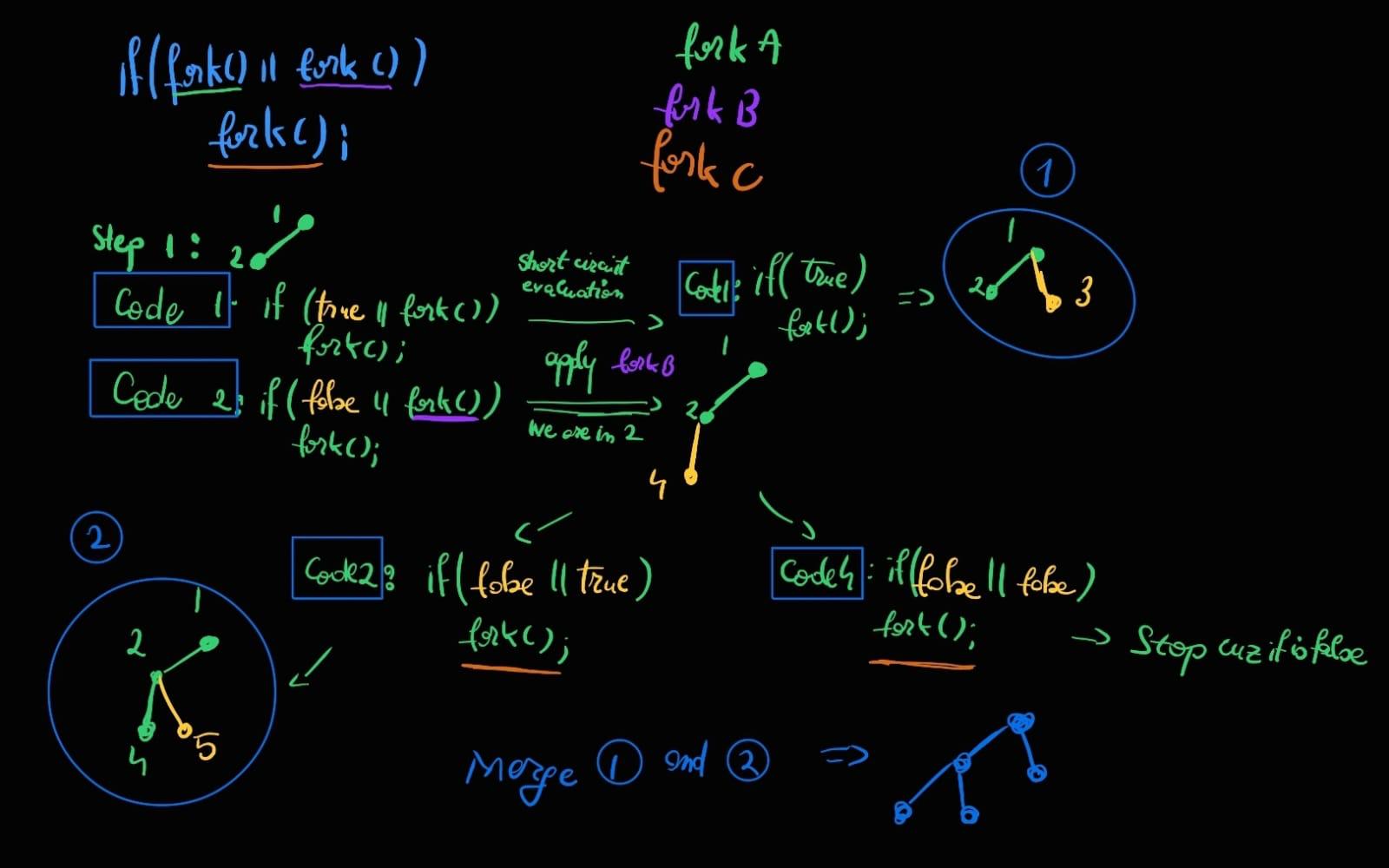
Exercise 4 (try yourself now and verify with the sample code)
if(fork() && (!fork())){
if(fork() || fork()){
fork();
}
}
Use fork in problems
Let's create a simple problem. We want to printf for n times "Hello world" and for each print we will use a child.
#include <dirent.h>
#include <stdio.h>
#include <errno.h>
#include <unistd.h>
#include <sys/wait.h>
#include <stdlib.h>
int main(int argc, char *argv[]){
//we create n processes
for(int i = 1; i <= atoi(argv[1]); i ++){
int pid = fork();
if (pid < 0){
return errno;
}
else if (pid == 0){
//kiddo
printf("Hello world, %d\n", i);
printf("Done Parent %d Me %d\n", getppid(), getpid());
return 0; //The child kills himself
}
}
//we wait after n processes
for(int i = 1; i <= atoi(argv[1]); i ++){
wait(NULL);
}
return 0;
}
At each iteration, we will do a fork and create a child which does what he needs to do and then returns 0.
The intuition is that we will have 2^n processes, but in fact we will have n processes because of return 0.
To ensure that our processes run in parallel, we need to do the last for (waiting n times). If we had put the wait command inside the first for loop, the processes would not run in parallel.
Further Reading
References
- https://stackoverflow.com/questions/985051/what-is-the-purpose-of-fork
- https://stackoverflow.com/questions/5839519/motivation-for-spawning-a-new-process-v-thread
- https://www.scaler.com/topics/c-fork/
- https://en.wikipedia.org/wiki/Pipeline_(Unix)
- https://en.wikipedia.org/wiki/Fork_bomb
- https://www.geeksforgeeks.org/fork-practice-questions/